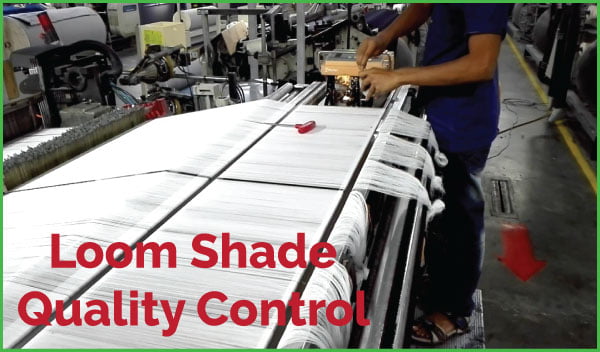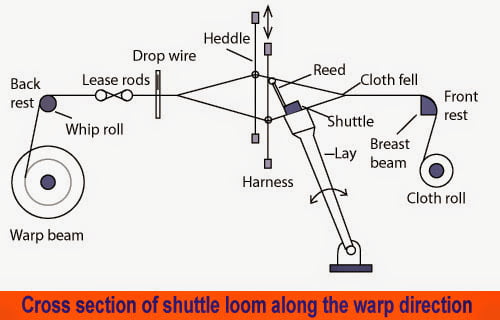Quality Control Activities in Loom Shed
Last updated on July 20th, 2023 at 11:05 pm
The quality control function is required to monitor the qualitative performance of the incoming material, in-process material and the finished product. This involves conducting of studies/tests, both routine and special.

Routine Studies
End Breaks and Operations
Warp and weft breakage studies should be conducted once a month for each count. The breaks should be noted case wise. In the case of ordinary looms, additional information regarding weft changes should be noted. From the data collected, warp and weft breakage rates, as also the weaver operations can be calculated for each count.
Efficiency
Loom-shed efficiency should be studied every day by conducting a snap round the department. If the number of looms in the shed is more than 1000, the round may have to be split in two parts to cover all the looms.
Fabric Defects
A snap round should be taken every day in the department for observing fabric defects. The number of rounds should be increased to 2-3 per day when the defects are excessive. While observing the loom for the incidence of fabric defects, the type of defect should be noted on an observation sheet. This will provide information on the commonly occurring types of defects and will also help to create quality consciousness among the weavers.
Speed Checking
Loom speeds should be checked at least once a month. The procedure to be followed is to rest a finger on the picking shaft of a loom and count the strokes for two minutes. A maximum loss of 2 rpm from the rated speed should be allowed.
Transfer Failures
Two percent of the total automatic looms must be studied every month of transfer failures, for one hour each. This study can be combined with the breakage study. The incidence of the transfer failures and lashing-in would indicate the performance of transfer mechanism.
Hard Waste
The hard waste level is to be calculated every month from records. This will show the general trend. It is suggested to keep a watch on the level of sweeping waste as weavers are often found to throw waste indiscriminately on to the floor.
Colored Weft Shade
A round should be conducted once a day to cover all looms and the pirns kept on the looms should be observed for shade variations. The weavers should be asked to segregate the light and dark pirns.
Ordinary Looms Working With One Shuttle
A snap round should be taken once a week or fortnight in the entire shed and looms working with only one shuttle, unworkable spare shuttle and spare shuttle under repair should be noted and the number expressed as a percentage of total looms observed.
Functioning of Warp Stop Motion
Every loom having a warp stop motion should be checked for its functioning once a fortnight or month. A snap round taken in the loom shed once a week or fortnight will help to observe the functioning of the mechanisms of automatic looms. This study can be combined with the snap study for fabric defects.
Survey of Ejected Pirns on Automatic Loom
The ejected pirns at the looms should be observed during the transfer failure study for the presence of excessively long length of yarn or absence of bunch.
Sortwise Efficiency
Sortwise efficiency should be calculated every month from records.
Maintenance Audit
When the Statistical quality control department is assigned the work of maintenance audit, counterchecks should be planned in accordance with the maintenance schedule.
Life Estimation of Stores Items
Sample trials are very essential to estimate life or quality level of an incoming lot. The sample size should not be too small as there can be very high sampling errors. It should also not be very large as it will demand considerable time and effort. Normally, a sample size of about 24 may be preferred for the trials. Even so, it is not necessary to wait till all the items are consumed, but a fair idea can be formed from a truncated sample when 50-79% of the items are consumed.
Productivity
Productivity calculations should be carried out once a month.
Stores Consumption
Stores consumption should be found out from records. This will indicate the looms consuming more than standard level of items.
Labor Employment
The average labor employment should be calculated once a month. This will help in avoiding the use of more than necessary labor force in the shed.
Fabric Inspection
About 2000 m each of grey and finished fabrics covering all the major sorts should be inspected every month on the inspection table for quality and incidence of fabric defects. The data so collected should be analyzed weaver wise and loom wise.
Packing and Baling Inspection
The entire operation of packing and baling should be counter—checked whenever required with respect to assortment, number of pieces, quality of work, slips, packing material etc.
Cut-looked Production
At least one piece from the cut-looked production should be checked twice a week, per cut-looker.
Humidity
A careful monitoring should be exercised and periodical readings taken on the hygrometers placed in different sections of the shed to maintain uniform relative humidity in the weaving shed all through the shift. Readings of the hygrometer kept outside and inside the shed should be taken at the same time. These observations may be carefully studied and used as guidance for controlling general humidity in the shed.
Reconciliation Between Yarn and Fabric
As a part of the management control, the SQC department should match the consumption of yarn and production of fabric through monthly reconciliation statements. Such a procedure helps to provide a continuous vigil on the entire production cycle and helps to assess the actual material losses in the form of process waste, invisible waste and so on. A reliable method for reconciliation has been developed by BTRA36.
Special Studies
Hard Waste
Whenever required, detailed cause wise hard waste studies should be conducted to pin-point the areas responsible for excessive hard waste.
Yarn Content on Weft Pirn
In the event of any problem regarding weft supply, yarn content of pirns should be checked either by measuring length of yarn on a few pirns individually or by checking the pirn doff weights. In the case of direct weft, count and yarn properties may also be checked.
You may also like: Main Check Points in Weaving



